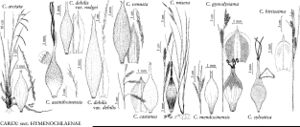Difference between revisions of "Carex arctata"
in W. J. Hooker, Fl. Bor.-Amer. 2: 227. 1839.
FNA>Volume Importer |
imported>Volume Importer |
||
| (One intermediate revision by the same user not shown) | |||
| Line 1: | Line 1: | ||
{{Treatment/ID | {{Treatment/ID | ||
|accepted_name=Carex arctata | |accepted_name=Carex arctata | ||
| − | |accepted_authority=Boott | + | |accepted_authority=Boott |
|publications={{Treatment/Publication | |publications={{Treatment/Publication | ||
|title=in W. J. Hooker, Fl. Bor.-Amer. | |title=in W. J. Hooker, Fl. Bor.-Amer. | ||
| Line 8: | Line 8: | ||
}} | }} | ||
|common_names=Drooping woodland sedge;carex comprimé | |common_names=Drooping woodland sedge;carex comprimé | ||
| + | |special_status={{Treatment/ID/Special_status | ||
| + | |code=F | ||
| + | |label=Illustrated | ||
| + | }}{{Treatment/ID/Special_status | ||
| + | |code=E | ||
| + | |label=Endemic | ||
| + | }} | ||
|basionyms= | |basionyms= | ||
|synonyms={{Treatment/ID/Synonym | |synonyms={{Treatment/ID/Synonym | ||
| Line 36: | Line 43: | ||
-->{{#Taxon: | -->{{#Taxon: | ||
name=Carex arctata | name=Carex arctata | ||
| − | |authority=Boott | + | |authority=Boott |
|rank=species | |rank=species | ||
|parent rank=section | |parent rank=section | ||
| Line 48: | Line 55: | ||
|publication title=in W. J. Hooker, Fl. Bor.-Amer. | |publication title=in W. J. Hooker, Fl. Bor.-Amer. | ||
|publication year=1839 | |publication year=1839 | ||
| − | |special status= | + | |special status=Illustrated;Endemic |
| − | |source xml=https:// | + | |source xml=https://bitbucket.org/aafc-mbb/fna-data-curation/src/2e0870ddd59836b60bcf96646a41e87ea5a5943a/coarse_grained_fna_xml/V23/V23_856.xml |
|genus=Carex | |genus=Carex | ||
|section=Carex sect. Hymenochlaenae | |section=Carex sect. Hymenochlaenae | ||
Latest revision as of 21:43, 5 November 2020
Plants densely cespitose. Culms dark maroon at base; flowering stems 20–100 cm, much longer than leaves at maturity, 0.6–1 mm thick, glabrous but scabrous within inflorescence. Leaves: basal sheaths maroon, bladeless, rarely minutely scabrous, glabrous; others grading from maroon to green on back, white to tan-hyaline on front, minutely red dotted; blades flat, 3–10(–13) mm wide, glabrous with minutely scabrous margins. Inflorescences: peduncles of lateral spikes slender, to 30 mm, shorter than spikes; peduncle of terminal spike to 28 mm, usually shorter than adjacent pistillate spikes, minutely scabrous on angles; proximal bracts shorter than inflorescences; sheaths to 30 mm; blades 2–3 mm wide. Lateral spikes 2–5, 1 per node, well separated, erect at anthesis, but soon drooping, pistillate with 15–45 perigynia attached 1–2 mm apart, linear-elongate, 25–80 × 3–4 mm. Terminal spike staminate, sessile or pedunculate, 6–40 × 0.8–2 mm. Pistillate scales white-hyaline with green midrib, oblong-lanceolate, shorter than mature perigynia, apex acuminate to cuspidate or awned, awn to 1.5 mm, margins and awn scabrous or ciliate, otherwise glabrous. Perigynia green, often red dotted, 2-ribbed and finely 10–15-veined, loosely enveloping achene, ellipsoid-ovoid, 3–5 × 1–2 mm, membranous, base with stipe 2–3 mm, apex tapering to minute beak, glabrous but sometimes ciliate between apical teeth; beak bidentate, 0.7–1.5 mm. Achenes sessile, 1.7–2.6 × 0.8–1.7 mm. 2n = 52, 54, 56.
Phenology: Fruiting late spring–mid summer.
Habitat: Northern hemlock-hardwood forests, boreal coniferous forests, white-cedar swamps, upland, dry to mesic deciduous forests
Distribution

Man., N.B., Nfld. and Labr., N.S., Ont., P.E.I., Que., Conn., Ind., Maine, Mass., Mich., Minn., N.H., N.Y., Ohio, Pa., R.I., Vt., Wis.
Discussion
Occasional specimens with late-flowering stems have shorter, more crowded pistillate spikes and resemble the type specimen for Carex arctata var. faxonii, but these are anomalous within populations and not deserving of taxonomic status. Specimens lacking vegetative shoots can be misleading because the leaves of the flowering stems are usually at least 2–3 mm narrower than those of the vegetative shoots. Nearly sterile hybrids with C. castanea (= C. ×knieskernii) are sporadic, but uncommon, occurring throughout the area where the ranges of the parental species overlap. Hybrids with C. gracillima and C. virescens have also been reported; their parentage has not been confirmed.
Selected References
None.
